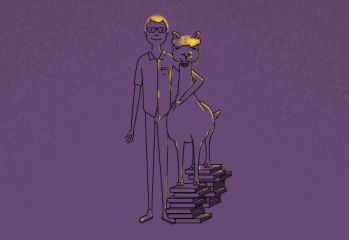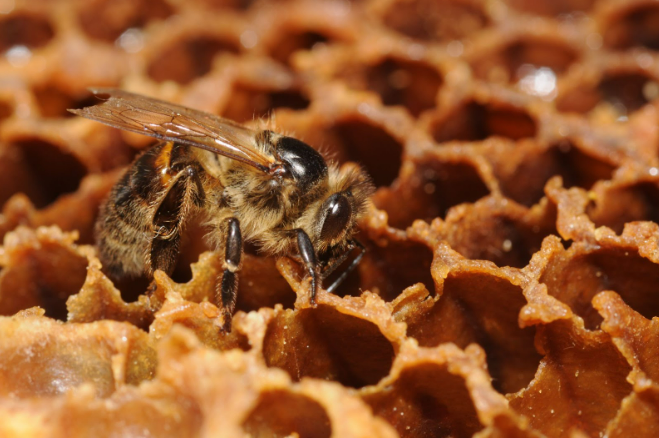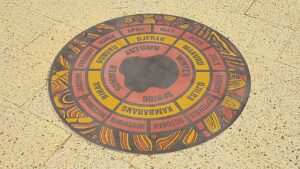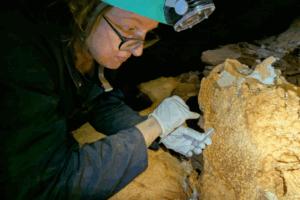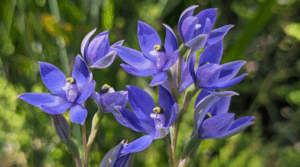Animals were once considered mindless – incapable of thoughts or feelings.
These views dominated common thought for millennia, until research indicated that mammals and birds can think and feel similarly to how we do.
Now the magnifying glass is being aimed even lower – the six-legged kingdom.
Is bigger better?
Ancient Greek philosopher Aristotle placed insects and arachnids 10th in his scale of nature hierarchy, stamped between snails and jellyfish.
It’s clear creepy crawlies are capable of something akin to thoughts. However, most seem to display very simple behaviours.

Credit: ABC iView via GIPHY
It was argued to be a matter of space. The brain of an ant has a mere 250,000 neurons compared to the 86 billion in a human head.
Despite this seeming limitation, modern research has revealed that the ants rummaging in your pantry are further enlightened than first thought.
It’s the complexity of the neuronal networks in the brain that matters rather than pure mass.
Swarm intelligence
Hymenoptera, the order enveloping bees and ants, exhibit complex behaviours like selective attention and social learning – both of which have long been observed in animals once thought to be of some ‘higher order’.
Each bee is an individual with a unique external experience, capable of deciphering conflicting food sources and potential threats and directing attention appropriately.

Credit: Cat Williams
A colony of bees will often put the benefit of the hive over the safety of the individual. It’s not about one bee but all of them.
When bee colonies grow too large for their hives or are struck by disease or infestations, legions of drones surround the queen all at once to relocate as a swarm.
Deceiving looks
Despite appearances, honeybee populations might not be as unthinking as it seems.
Dr Kit Prendergast is a native bee ecologist and science communicator.
“Most of the over 20,000 species of bees in the world aren’t eusocial and don’t live in big colonies with the queen,” says Kit.
Eusocial is the term applied to species that display organised social structures. Despite names like ‘drone’ and ‘worker’, bees can do more than we realise.
Swarm behaviour is restricted to a very small subset of bees, but those that use this strategy are highly impressive.
Caption: Endangered Australian blue-banded bees (Amegilla cingulata)
Credit: Mark Kineth Casindac, CC BY-SA 4.0, via Wikimedia Commons
Superorganisms
Although they might seem a rabble, biologists note that Hymenoptera colonies can be borderline bureaucratic. Everyone has a job to do.
They’ve termed these species ‘superorganisms’.
Leafcutter ants, for instance, are essentially six-legged farmers. They cultivate fungi on sections of leaves before they slice their reapings away and deliver them back to the colony.
In bees, the decision-making process can be influenced by temperature or population density. In some cases, bees have certain jobs. There are even undertaker bees, whose role is to check over the entire colony and remove all the deceased bees from the hive.
“The individual honeybees do have autonomy,” says Kit. “They’re not controlled like robots from a central system.”
Bee-haviour
Kit says it’s important to understand that bees are able to think and have some sort of feelings.
We seem to uncover more about their cognitive capacities every day.
Shocked researchers even managed to coax bumblebees into playing soccer.
When worker honeybees find a good nectar source, they waggle and dance vigorously back at the hive.
The dance, in a figure-eight shape, is more than a brag about a successful forage.
It’s more like a detailed map. Bees point their dance moves towards the food source, in relation to the Sun. The longer the jig lasts, the further their fellow foragers know to fly.
The youngest bees learn to do the figure-eight dance socially, from their elders.
Caffeine in some flowers can even entice bees, making them more likely to remember the nectar source.
They’ll keep going back to their favourite coffee shop even when there are better, more nectar-full options – just lacking caffeine.
Or the barista remembers their name, and they like that sort of thing.
